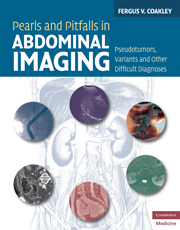Book contents
- Frontmatter
- Contents
- Preface
- Acknowledgements
- Section 1 Diaphragm and adjacent structures
- Section 2 Liver
- Section 3 Biliary system
- Section 4 Spleen
- Section 5 Pancreas
- Section 6 Adrenal glands
- Section 7 Kidneys
- Case 40 Radiation nephropathy
- Case 41 Lithium nephropathy
- Case 42 Pseudoenhancement of small renal cysts
- Case 43 Pseudotumor due to focal masslike parenchyma
- Case 44 Pseudotumor due to anisotropism
- Case 45 Echogenic renal cell carcinoma mimicking angiomyolipoma
- Case 46 Pseudohydronephrosis
- Case 47 Pseudocalculi due to excreted gadolinium
- Case 48 Subtle complete ureteral duplication
- Section 8 Retroperitoneum
- Section 9 Gastrointestinal tract
- Section 10 Peritoneal cavity
- Section 11 Ovaries
- Section 12 Uterus and vagina
- Section 13 Bladder
- Section 14 Pelvic soft tissues
- Section 15 Groin
- Section 16 Bone
- Index
- References
Case 42 - Pseudoenhancement of small renal cysts
from Section 7 - Kidneys
Published online by Cambridge University Press: 05 November 2011
- Frontmatter
- Contents
- Preface
- Acknowledgements
- Section 1 Diaphragm and adjacent structures
- Section 2 Liver
- Section 3 Biliary system
- Section 4 Spleen
- Section 5 Pancreas
- Section 6 Adrenal glands
- Section 7 Kidneys
- Case 40 Radiation nephropathy
- Case 41 Lithium nephropathy
- Case 42 Pseudoenhancement of small renal cysts
- Case 43 Pseudotumor due to focal masslike parenchyma
- Case 44 Pseudotumor due to anisotropism
- Case 45 Echogenic renal cell carcinoma mimicking angiomyolipoma
- Case 46 Pseudohydronephrosis
- Case 47 Pseudocalculi due to excreted gadolinium
- Case 48 Subtle complete ureteral duplication
- Section 8 Retroperitoneum
- Section 9 Gastrointestinal tract
- Section 10 Peritoneal cavity
- Section 11 Ovaries
- Section 12 Uterus and vagina
- Section 13 Bladder
- Section 14 Pelvic soft tissues
- Section 15 Groin
- Section 16 Bone
- Index
- References
Summary
Imaging description
Renal cyst pseudoenhancement is the artifactual increase in CT density that can be seen in small (less than 15 mm in diameter) simple renal cysts after the intravenous administration of iodinated contrast material (Figure 42.1) [1–4]. Pseudoenhancement is not simply due to partial volume averaging, because the artifact occurs even in experimental phantom studies where the effects of partial volume averaging have been removed. Pseudoenhancement is believed to be a consequence of beam-hardening effects of the enhanced renal parenchyma combined with artifact introduced by the CT image reconstruction algorithm [1].
Importance
Solid renal masses are typically distinguished from renal cysts at CT by the presence of enhancement after the intravenous administration of iodinated contrast material, and an increase in density of 10 Hounsfield Units has generally been regarded as the threshold for enhancement [5]. Pseudoenhancement may therefore lead to mischaracterization of a small renal cyst as an enhancing neoplasm and unnecessary intervention.
Typical clinical scenario
Renal cysts are present in 20 to 40% of the population [6]. Small renal cysts are particularly common. In one study, 67 of 258 patients (26%) undergoing CT had one or more renal cysts (as proven by MRI) of 10 mm or less in diameter [7]. In another study, 38% of simulated cysts measuring up to 15mm in diameter demonstrated pseudoenhancement with an increase in density that ranged from 10.3 to 28.3 Hounsfield Units [8]. Factors that increase the likelihood of pseudoenhancement are smaller cyst size, higher background renal parenchymal enhancement, a higher number of CT detector rows, and higher kVp [1–3, 9–11].
Information
- Type
- Chapter
- Information
- Pearls and Pitfalls in Abdominal ImagingPseudotumors, Variants and Other Difficult Diagnoses, pp. 142 - 143Publisher: Cambridge University PressPrint publication year: 2010
